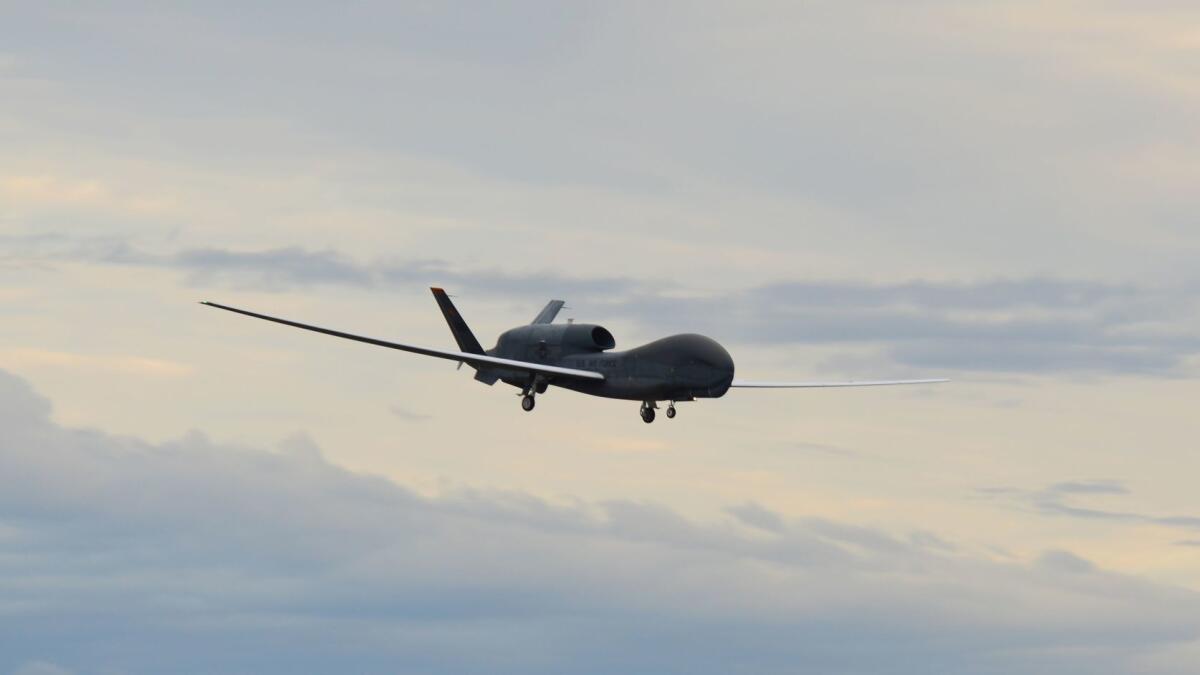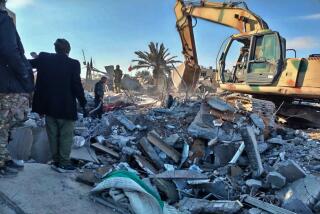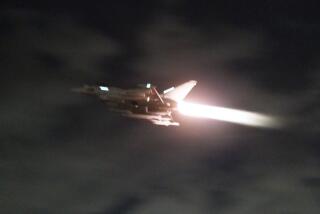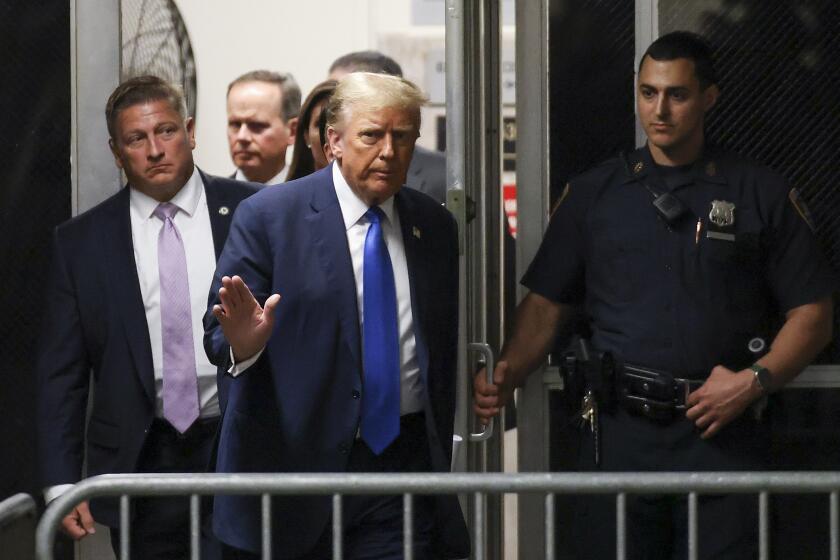Trump downplays Iranian shootdown of U.S. surveillance drone

An unarmed U.S. surveillance drone was shot down by a missile fired from Iran, the Pentagon said Thursday, but U.S. and Iranian military officials disputed whether the unmanned aircraft was in Iranian airspace and President Trump downplayed the attack, calling it a mistake.
The incident was the most serious military clash between the U.S. and Iran since the Pentagon began beefing up its presence in the Middle East in early May, saying intelligence indicated that Iran was preparing to attack U.S. forces or allies.
While he may still order retaliation, Trump sought to ease tensions, suggesting the downing of the Navy’s RQ-4 Global Hawk unmanned aircraft by an Iranian surface-to-air missile was inadvertent or a misjudgment by a rogue Iranian military officer or unit.
“I have a feeling it was a mistake made by someone who shouldn’t have been doing that,” Trump told reporters in the Oval Office. “I find it hard to believe it was intentional.”
Shunning the bellicose language he often employs, Trump referred to the drone strike as “a new wrinkle, a new fly in the ointment” in the decades-old standoff between the United States and Iran, but not as a reason to go to war.
The two governments disputed precisely where the aircraft was shot down, with Iran saying it downed the drone over its territorial waters near the Strait of Hormuz, a vital waterway for global oil shipments.
The Pentagon said the drone was in international waters 21 miles offshore, and released a revised map late Thursday showing the drone’s flight path and point of attack. Both were outside Iran’s claimed territorial waters, which were also marked on the map.
Iranian officials and commanders made clear that the missile was fired deliberately to defend Iranian territory, and was not an accidental launch, as Trump had suggested.
In a tweet, Iran’s foreign minister, Mohammad Javad Zarif, said the Navy drone took off from the United Arab Emirates “in stealth mode and violated Iranian airspace” just after 4 a.m. local time. He added, “We’ve retrieved sections of the U.S. military drone in OUR territorial waters where it was shot down.”
Zarif said Iran would take the issue to the United Nations Security Council to prove the U.S. drone was downed in Iranian airspace, and not over international waters as the Pentagon claimed.
U.S. officials have warned in recent days that Iran could face reprisals if it caused American casualties, and Pentagon officials have been preparing options for limited military strikes. Trump appeared relieved that the downed aircraft was remotely piloted.
“We had nobody in the drone,” he said. “It would have made a big difference.”
Trump may yet be swayed to respond by his senior advisors, including national security advisor John Bolton and Secretary of State Michael R. Pompeo, both longtime hawks on Iran.
The Pentagon’s usual instinct to retaliate may be muted, with the department’s civilian leadership in flux. Acting Defense Secretary Patrick Shanahan is due to leave office Monday, and Army Secretary Mark Esper will take over as acting secretary of Defense.
House Speaker Nancy Pelosi (D-San Francisco) said administration officials would brief lawmakers Thursday on what she called “a dangerous situation.”
“The president may not intend to go to war here, but we’re worried that he and the administration may bumble into a war,” said Senate Minority Leader Charles E. Schumer (D-N.Y.).
Washington and Tehran have both made carefully calibrated moves over the last month, raising tensions in the region but stopping short of direct clashes.
Iran has demonstrated “canny and calculated escalation” by targeting unmanned U.S. aircraft, foreign-flagged oil tankers and other civilian targets in the region, said Chris Dougherty, a senior fellow at the Center for a New American Security, a centrist think tank in Washington. “They have avoided killing U.S. personnel while showing that Iran is willing and able to strike critical targets.”
Iran’s Revolutionary Guard claimed responsibility for the missile launch. The unarmed Global Hawk flies at high altitudes, sending live video feeds from advanced cameras and other data from sensors to installations in the region and in the United States.
“This was an unprovoked attack on a U.S. surveillance asset in international airspace,” said Capt. Bill Urban, a Pentagon spokesman.
Pentagon to send 1,000 more troops to Middle East as tensions rise with Iran »
The Revolutionary Guard released a video showing a missile firing into the night sky. After a fiery explosion when the missile appears to strike a target, cries of “God is great” can be heard.
The Pentagon released grainy video of the aftermath of the missile strike, showing a piece of unidentifiable debris falling into what looks like the sea with a plume of smoke behind.
Lt. Gen. Joseph Guastella, the U.S. Air Force commander in the Middle East, said the drone was flying about 21 miles “from the nearest point of land on the Iranian coast,” near the entrance to the Strait of Hormuz, when it was hit.
A map made public in Zarif’s tweet appeared to place the missile strike closer to Iran’s shoreline, near the town of Kooh Mobarak.
The question of whether the drone was hit in international airspace rests in part on a longstanding dispute between the U.S. and Iran over Tehran’s claim of territorial sovereignty over the waters and airspace up to 12 miles off its coastline, said Lawrence B. Brennan, a retired Navy captain and maritime law expert at Fordham University in New York.
The U.S. claims it has the right to fly and sail anywhere in the strait, which is 21 miles across at its narrowest point, because international law protects the right of all nations to peacefully transit such waterways.
“Under customary law, aircraft and ships have the right of innocent passage through the strait, anywhere in the strait, because it is a strait,” Brennan said.
Iran’s assertion that the drone was operating “in stealth mode” suggests it is seeking to build a case that the plane was spying, instead of transiting the strait for peaceful purposes, as required under international law.
But Guastella said the drone was there to protect international shipping. “This attack is an attempt to disrupt our ability to monitor the area following recent threats to international shipping and free flow of commerce,” he said.
In a speech carried live on Iranian state television, Gen. Hossein Salami, commander of Iran’s Revolutionary Guard, called the shooting-down a “clear message” to America. Iran, he said, does “not have any intention for war with any country, but we are ready for war.”
The incident occurred four days after the Pentagon said Iran had tried to down another drone, which was flying near one of two oil tankers hit by explosions in the Gulf of Oman. That missile missed the drone by more than half a mile, the Pentagon said.
Iran turns back to nuclear program a year after Trump pulled out of disarmament accord »
The U.S. has blamed Iran for fiery explosions on two oil tankers, saying limpet mines were attached to the hulls, though it has not released evidence that proves Tehran’s involvement. Iran has denied responsibility.
On Thursday, Navy Cmdr. Sean Kido, who is leading the investigation into the tanker explosions, told reporters at a Navy facility in the United Arab Emirates that the limpet mine used in the attack resembled “Iranian mines that have already been publicly displayed in Iranian military parades.”
The U.S. has rapidly built up its military forces in the region since early May, sending an aircraft carrier battle group, a fighter squadron, B-52 bombers, anti-missile batteries and other forces totaling around 8,500 troops. More than 30,000 troops are already stationed there.
In Washington, concerns about the growing tensions quickly spilled into the 2020 presidential campaign and into the halls of Congress.
Democrats in the Senate called for a vote on an amendment to the National Defense Authorization Act in a bid to block Trump from waging what they called an unauthorized war.
The proposed amendment would prohibit money from being used for military action against Iran “without explicit authorization from Congress.”
“To engage in another war in the Middle East would represent a catastrophic failure of foreign policy,” said Sen. Tim Kaine (D-Va.).
“Failure to have that debate is so unfair to our troops” who “put their lives on the line” while “members of Congress hide under their desks,” he added.
Iran’s behavior isn’t as mysterious as it looks »
Former Vice President Joe Biden, who is running for president, called Trump’s policies toward Iran a “self-inflicted disaster” and suggested Trump’s withdrawal from the 2015 nuclear deal with Iran had led to the current turmoil.
“By walking away from diplomacy, Trump has made military conflict more likely. Another war in the Middle East is the last thing we need,” Biden said.
Sen. Lindsey Graham (R-S.C.) blamed Iran for the heightened tensions, noting Tehran had rebuffed Trump’s offer of direct talks with Iran’s supreme leader, Ali Khamenei. Japanese Prime Minister Shinzo Abe conveyed the offer during a visit to Tehran last week but Khamenei publicly rejected it, saying Trump could not be trusted.
Graham urged the White House to target Iran’s naval capabilities and oil refineries — calling them the “economic lifeblood of this murderous regime” — if it decides to respond with force.
Times staff writers Noah Bierman, Jennifer Haberkorn, Eli Stokols and Tracy Wilkinson contributed to this report.
More stories from David S. Cloud »
More to Read
Get the L.A. Times Politics newsletter
Deeply reported insights into legislation, politics and policy from Sacramento, Washington and beyond. In your inbox three times per week.
You may occasionally receive promotional content from the Los Angeles Times.







